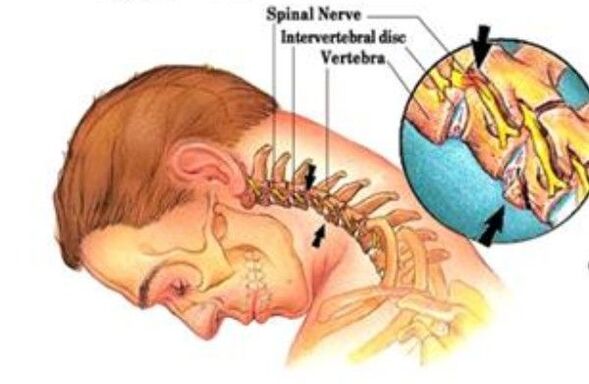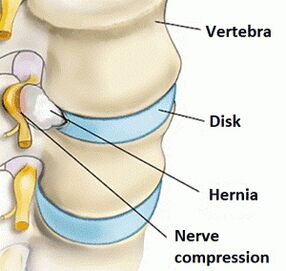
Neck pain is a alarming sign.Maybe this is just an overvoltage and you just need to relax and relax.But what if pain is associated with cervical spinal osteochondrosis?It is important to be careful to consider symptoms and treatment, as complications can affect the most important organs - the brain.
What is the cervical osteochondrosis
Cervical spinal osteochondrosis is a degenerative disease of the bone cherry system.It leads to the destruction of the cervical intervertebral disc, the growth of the vertebral bone tissue, the formation of growth on their surface.
The cervical bone is made up of seven vertebrae, the first to be articulated with the skull.The anatomical and functional units of the spine are the spinal motor segment.This is a shared complex, as the spinal column moves.The complex consists of two vertebrae, intervertebral disc, articular surface of the vertebra (aspect), nerves, ligaments and muscles.
Osteochondrosis begins with damage to the intervertebral disc and affects all surrounding tissues.Over time, the process leads to the overall biomechanical violation of the spinal cord.With the development of osteochondrosis, intervertebral disc hernia, nerve root and blood vessels can be formed.
The pathological process in the intervertebral disc occurs four stages: diet, ligaments' weakness, damage to disc and nerve compression.

- Stage 1.The state of the power and metabolism of the intervertebral disc is violated.Due to the structural features, the disc is only eaten during movement.If not, dystrophic tissue changes begin: starvation discs and dehydration.Water loss leads to the fact that the intervertebral disc is unable to perform the depreciation function.The load on the fibrous ring is increasing, cracks and tears appear in it.Currently, small pain may arise.
- Level 2.In the second stage, the vertebral segment ligaments occur.The connection becomes pathologically mobile.The pathological process in the disc is aggravated, the hernia (prolapse) begins - absorb the pulpoose nucleus through the crack in the fibrous ring.The pain becomes periodic.
- Stage 3.Further, the intervertebral disc is completely damaged.The essence of the disc pulpoose goes beyond the fibrous ring.The resulting hernia can break the nerve root.The process of inflammation develops.This is indicated by pain, coordinated radical syndrome.
- Stage 4.In the fourth stage, the defeat affected the fabric nearby.It is possible to squeeze the radicular artery, leading to a lack of blood supply to the spinal cord.As a result, the spine can completely move.
The first sign and the main symptoms
At the beginning of the development of osteochondrosis of the cervical area, discomfort, movement limit, neck pain.Often this does not attach interest.
Over time, pain is increasing, pain, burning, head, neck, shoulder blades, shoulders - may produce vertebral artery syndrome.The artery is squeezed or spasmodic, the blood flow is disrupted.
In 1-2 stages of cervical osteochondrosis, optalmological problems related to cramps in vessels often occur.Dark in the eyes, blinks, "flies", colored spots in front of the eyes - all of these are symptoms of osteochondrosis.
The most common symptoms of cervical osteochondrosis:
- Migraine, dizziness, nausea and cough.
- Hearing deterioration, ear pain, face.
- Motor interference in the hands, feet.Skin sensitivity to the head may be a gap.
- It hurts in hand.If the nerve spine is pinched, then the whole area where he sends impulses can hurt or "fall".
In addition to the above symptoms, you can distinguish three major pain syndrome, which accompanies cervical spinal osteochondrosis.This syndrome is a symptom of the overall complex.Determination of major pain syndrome is important, as the entire treatment regimen is built to eliminate pain.And it is impossible to eliminate it without knowing the origin.
- Miofascial Syndrome- Pain in skeletal muscles and adjacent fascia.This violation is associated with a load, in which cramps, hypertonicity, painful nodes in the muscles (triggers) occur.
- Rook Syndrome- The pain caused by prolonged redness of the spinal cord.The process of hernial formation for spinal osteochondrosis leads to pinching nerve fibers and subsequent inflammatory reactions.The pain spreads along the nerves.
- Facet Syndrome- Pain in the vertebrate.The second vertebrae of the cervix has an articular process, which is related to the curved joint (aspect).With osteochondrosis, the intervertebral disc is destroyed, their height decreases, and this leads to the fact that the joint joint capsule is in constant tension.This causes pain.In addition, the pain increased at the end of the day, especially with a long forced position.
Causes of osteochondrosis in the cervical spine One of the main causes of osteochondrosis is the evolution of the spine to a high vertical load.The ancestors of people walked on four feet, like other mammals.They do not experience osteochondrosis, because in the horizontal position of the intra -disconed body is half as in vertical.With evolutionary standards, the transition to the steam occurred not long ago, and the spine just didn't have time to adjust to the high vertical load.Therefore, together with the straightener, one also obtains the disease of the musculoskeletal system.
A neck that is more vulnerable to someone makes a structure.A person's cervical department is made up of seven small mobile vertebrae, which is articulated by the type of pyramid of children.This design cannot be called stable outside the rest.In addition, the muscle frames in this zone are weak, and the load can be high - all of which makes the neck exposed.Any injury is full of consequences.Although the damage is located in the other spine, the redistribution of the load can cause osteochondrosis.
Another factor is aging.The formation of skeletal and cartilage ends ends with 21 and subsequently the aging (degeneration) process that cannot be restored begins.Cartilage food is only carried out due to the spread, and if the intervertebral disc does not receive nutrients, it begins to gradually collapse.
In addition, the development of cervical osteochondrosis contributes to:
- Autoimmune disease.They involve their own cells in the pathological process of the destruction of cartilage tissue.
- Infections, hormone failure, decreases in metabolism - all of these circulatory disorders can also serve as a factor for the development of osteochondrosis.
- Inactivity lifestyle, a working condition in which a person spends most of the time in a forced static position.
- High loads leading to injury can lead to compression.
- Genetic defects associated with weakness of the musculoskeletal system and low -prone bone fabric.
The spinal canal in the cervical spine is very narrow, so that the burden is high, any violation or injury can cause spinal cord compression.And this is very dangerous.
In addition, a large number of nerve endings and blood vessels past this area.If the blood stops flowing into the brain in the right amount, the stroke may occur.
Diagnostics
In the main diagnosis of cervical osteochondrosis, the doctor collects the patient's history.He finds that and how it hurts, with what intensity, with a burden or rest, at that time it hurts stronger, whether the cervical spine has occurred.
During the neck examination, doctors feel the cervical and muscle vertebra, lymph nodes;Evaluate the amount of movement, excluding or verifying the rooser syndrome.
Subsequently, laboratory diagnosis is prescribed to exclude autoimmune diseases: general blood tests, ESR, rheumatoid factors, HLA B27 antigens.
The main role in the diagnosis is given to radiography, calculated tomography and magnetic resonance imaging.
- RntgenographyIt helps assess the condition of the bone structure, soft tissue and cartilage in the picture.To visualize this structure, contrast mediums are introduced: angiography, discography, myelography.
- Computed tomography (CT).This method also uses radiographic principles, but using computer processing, you can get a series of longitudinal and horizontal images where you can see bones and cartilage.
- Magnetic resonance tomography (MRI).It is a "gold standard" in the pathological diagnosis, including cartilage and soft tissue.MRI gives an idea not only about the structure of the organ and tissue, but also works.In the case of osteochondrosis with frequent complications, there is a spinal hernia.MRI allows you to diagnose the process of hernia in the early stages.
Treatment
Treatment of cervical spinal osteochondrosis is reduced to conservative methods.Initially, the pain syndrome was released, and then various procedures were prescribed.But in the most extreme cases, when the pain has not passed for more than three months and the medication does not help, the surgery becomes the only way out.
Non -Kurgia treatment methods
Osteochondrosis has hit the bone system for more than a year, and therefore treatment will take time.Patience must be obtained.Conservative treatment tasks:
- Get rid of pain.
- Remove inflammation.
- Restore the function of the spinal cord.
- Strengthen muscle corsets and ligaments.
Conservative treatment includes drug therapy and physiotherapy.Preparation helps relieve pain during severity, and physiotherapy - to launch self -processing.
During severe pain with radicular syndrome, the "blockade" is performed: the drug is administered around the spinal cord area.
Physiotherapy treatment is based on natural and artificial physical factors: cold, heat, electrical current, magnetic radiation, laser and others.For their reconstruction, special devices, devices, manual methods are used.
- Laser therapy- Biological activation of the intervertebral disc regeneration process.The body starts to become yourself.
- Plasmotherapy (PRP therapy)- Plasma injection isolated from the patient's blood.Plasma is rich in platelets, growth factors, hormones.After injection, local immunity increases, the regeneration process is launched.
- Acupuncture- Stimulation of nerve endings with special needles.Increase metabolism in the affected area, relieving pain.
- Shock wave therapy- Exposure to high frequency waves.Allows you to start a natural recovery process.
- Kinesitherapy- Movement therapy.It can be active (exercise therapy) and passive (massage, attractiveness).The LFK strengthens the back muscles, the attractiveness relieves tension and pain.It is selected taking into account the individual characteristics of the patient.
- Therapy and manual massage- Exposure to soft tissue and joints to restore balance in the body and synchronization of the process.Restore mobility and relieve pain.
- Recording- Attach special plaster to the skin in places where it needs to affect the stretching receptors and compression of the muscles.It can relax and improve tone.
During acute pain, patients are recommended to wear special wraps and collar to the neck.
The positive effects of conservative treatment are achieved in 2-3 months.If there is no results, the patient is recommended.
Osteochondrosis Treatment Methods
The operation in the case of cervical osteochondrosis is an extreme measure required by special indicators.This operation is recommended if:
- Pain cannot be released by therapeutic treatment for more than 3 months.
- There is an intervertebral disc hernia.
- Sensitivity in the limbs are lost
Post -operative recovery also takes time and may include therapeutic treatment.
Cervical osteochondrosis is a complex degenerative disease.You can't treat it.Serious violations of the musculoskeletal system can cause defects.Neck pain can be chronic, osteochondrosis spreads to several parts of the spine.Timely prevention can prevent the development of the disease.
Prevention
To maintain the health of the cervical spine, daily physical activity is required.Intervertebral disc foods occur in motion, so much needed.It is important that the load is optimal and normal.
If the work is related to continuous discovery in a static position, periodically is required.And at home after a working day, you can lie on your back on a flat surface for some time, placing a roller under the neck.This method will help restore the cervical bend of the spine, removing muscle tension.
In the prevention of cervical osteochondrosis, proper pose during sleep is important.If someone in the morning goes up with pain in his neck, then the muscles do not have time to rest and recover.
Here, orthopedic pillows, individually selected, for 3-5 years will help.
Do not delay the treatment
Your doctor will help you choose a recovery program.He will evaluate the condition of the spinal cord in the MRI image, reporting the probability of resorption and the possibility of treatment.























